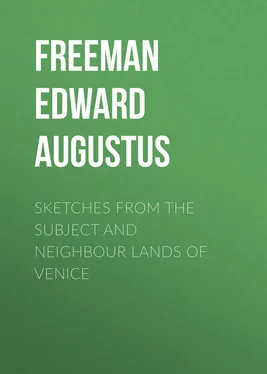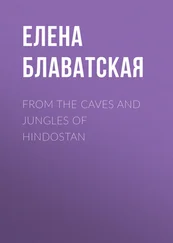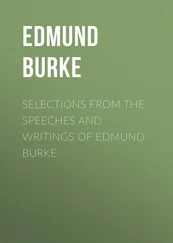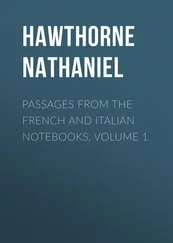Edward Freeman - Sketches from the Subject and Neighbour Lands of Venice
Здесь есть возможность читать онлайн «Edward Freeman - Sketches from the Subject and Neighbour Lands of Venice» — ознакомительный отрывок электронной книги совершенно бесплатно, а после прочтения отрывка купить полную версию. В некоторых случаях можно слушать аудио, скачать через торрент в формате fb2 и присутствует краткое содержание. Жанр: foreign_antique, foreign_prose, Путешествия и география, на английском языке. Описание произведения, (предисловие) а так же отзывы посетителей доступны на портале библиотеки ЛибКат.
- Название:Sketches from the Subject and Neighbour Lands of Venice
- Автор:
- Жанр:
- Год:неизвестен
- ISBN:нет данных
- Рейтинг книги:3 / 5. Голосов: 1
-
Избранное:Добавить в избранное
- Отзывы:
-
Ваша оценка:
- 60
- 1
- 2
- 3
- 4
- 5
Sketches from the Subject and Neighbour Lands of Venice: краткое содержание, описание и аннотация
Предлагаем к чтению аннотацию, описание, краткое содержание или предисловие (зависит от того, что написал сам автор книги «Sketches from the Subject and Neighbour Lands of Venice»). Если вы не нашли необходимую информацию о книге — напишите в комментариях, мы постараемся отыскать её.
Sketches from the Subject and Neighbour Lands of Venice — читать онлайн ознакомительный отрывок
Ниже представлен текст книги, разбитый по страницам. Система сохранения места последней прочитанной страницы, позволяет с удобством читать онлайн бесплатно книгу «Sketches from the Subject and Neighbour Lands of Venice», без необходимости каждый раз заново искать на чём Вы остановились. Поставьте закладку, и сможете в любой момент перейти на страницу, на которой закончили чтение.
Интервал:
Закладка:
Some of the guide-books call Udine "a miniature Venice;" it is not easy to see why. There are some canals and bridges in Udine, but so there are in Milan, Amiens, and countless other towns. There is even a Rialto; but one hardly sees how it came by its name. The true "piccola Venezia" is far away in Dalmatia, floating on its islands in the bay of Salona. The point of likeness to Venice is probably found in the civic palace and the two neighbouring columns. But these last are only the usual badges of Venetian rule, and the palace, though it may suggest the dwelling of the Doges, has no more likeness to it than is shared by many other buildings of the same kind in Italy. But, like or unlike to Venice, there is no doubt, even on a rainy day, that the palace of Udine is a building of no small merit; on a fine day it might perhaps make us say that it was worth going to Udine to see it. It is, of course, far smaller than the Doges' palace; and if it lacks the wonderful intermediate story of the Venetian building, it also lacks the ugly story above it. The point of likeness, if any, lies in the arcades, with their columns of true Italian type, slenderer than those at Venice, and using the pointed arch in the outer and the round arch in the inner range. But the columns at Udine are not a mere range like those at Venice. They stand row behind row, almost like the columns of a crypt, and they supply a profitable study in their floriated capitals. The pillared space forms the market-place of the city, and a busy place it is at the times of buying and selling, filled with the characteristic merchandise of the district, the golden balls of silk, for whose presence the Venetian land may thank the adventurous monks of Justinian's day. Some of the columns, and a large part of the rest of the building, had been renewed between 1875 and 1881. Between those years the palace had been nearly destroyed by fire. Here was a case of necessary restoration. No rational person could have been better pleased, either if the palace had been left in ruins or if it had been repaired in some incongruous fashion. In such a case as this, the new work is as much in its place as the old, and the new work at Udine is as worthy as any new work is ever likely to be to stand side by side with the old. At Udine again, as in many other places, the thought cannot fail to strike us how thoroughly these grand public palaces of Italy do but set before us, on a grand scale and in a more ornamented style, a kind of building of which a humble variety is familiar enough among ourselves. Many an English market-town has an open market-house with arches, with a room above for the administration of justice or any other public purpose. Enlarge and enrich a building of this kind, and we come by easy steps to the palace of Udine and to the palace of Venice.
The civic palace is the only building of any great architectural value in Udine. The metropolitan church contains little that is attractive for antiquity or for beauty of the higher kind. But the interior, though of mixed and corrupt style, is not without a certain stateliness, and its huge octagonal tower would have been a grand object if its upper stages had been carried up in a manner worthy of its basement. The streets are largely arcaded; and if the arcades of Udine supply less detail than those of some other Italian cities, any arcade is better than none. Udine can at least hold its head higher than modern Bari, modern Athens, modern Rome. Still at best Udine in itself holds but a secondary place among Italian cities, and its main historic interest consists in the way in which the utterly obscure Vedinum contrived to supplant both Aquileia and Forum Julii. As things now are, Forum Julii, dwindled to Cividale, has become a kind of appendage to Udine, and we must make our way thither from what is now the greater city.
Let us here put on record the memories of an actual journey, as strengthened and corrected by a later one made under more favourable circumstances. The accounts in the common guide-books are so meagre, and it is so impossible to get any topographical books in Udine, that our inquirer sets out, it must be confessed, with the vaguest notions of what he is going to see. Gsel-fels was not in those days, and, now that he has come into being, he has treated the lands at the head of the Hadriatic a good deal less fully than he has done most other parts of Italy. The traveller then is promised a store of Roman remains by one guide-book, and an early Romanesque church by another. He knows that the greatness of Forum Julii has gone elsewhere, and he is perhaps led to the belief that he is going to see a fallen city, perhaps another Aquileia, perhaps even another Salona. One thing is clear, even in the rain – namely, that the natural surroundings of Forum Julii are of the noblest kind. The grand position of the place itself he will not find out till later; but the mist half hides, half brings out, the fact that Udine lies near, and Cividale lies nearer, to the great range of the Julian Alps. Here and there their outlines can be made out; here and there a snowy peak shows itself for a moment in the further distance. A fertile plain with a mountain barrier, with broad and rushing rivers to water it – it was clearly a goodly land in which the old Veneti had fixed themselves, and in which Rome fixed the Forum of Julius as a colony and garrison to keep their land in obedience.
A long and flat road, but with the mountains ever in front, leads on by several villages with their bell-towers, over what, according to the accidents of weather, may be either a half-dry ghiara or a deep flood, till the traveller reaches the place which was Forum Julii, and which is Cividale. Here he finds himself – a little to his amazement – in a living town, with walls and gates and towers, with streets and houses and churches, none of them certainly of the Julian æra. The town is not very large; it is not a local capital like Udine; still it is a town, not a village among ruins and fragments like Aquileia and Salona. But it is plain that Cividale has not forgotten what she once was; the traveller is set down at the Grande Albergo al Friuli , and the albergo stands in the Piazza Giulio Cesare . He remembers the like name at Rimini, and he begins to cherish hopes that the treasures of Rimini may have their like at Cividale. In utter ignorance of what the place may really contain, he seeks for a bookseller's shop, hoping that some guide-book or plan of some kind may still be found. The bookseller is soon found, but his shop contains nothing of the least profit to an inquirer into the remains of Forum Julii. But the traveller hears that there is a museum; that promises something: besides the treasures which the museum itself may contain, such a place commonly implies an intelligent keeper, who sometimes proves to be a scholar of a high order. But he takes a wrong turn; no great harm however, as he thereby learns sooner than he otherwise would have learned the noble natural site of Cividale, planted on the rocky banks of the rushing stream of the Natisone. He sees two or three unpromising churches, and looks into the chief of them, a building of strange and mixed style, but not without a certain stateliness of general effect. He sees the Via Cornelio Gallo , which promises something, and the Via del Tempio , which promises more. Visions of Nîmes, Vienne, and Pola rise before him; he follows the track, but he finds nothing in the least savouring of Jupiter or Diana, and he learns afterwards that the Tempio from which the street is called is the great church, known, it seems, in a special way, as Templum Maximum . Still the museum is not reached; but a second inquiry, a second journey to quite another end of the town, leads to it. The museum is examined; it contains a considerable stock of objects of the usual kind, fragments of architecture and sculpture, which witness to the former greatness of Forum Julii. More remarkable are the specimens of Lombard workmanship, in various forms of armour and ornament, to say nothing of the actual tomb of the Lombard Duke Gisulf. At the museum he is put under the friendly guidance of a kindly priest, by whose care many matters are cleared up. Roman remains, strictly so called, there are none to see. There have been diggings, and the walls have been traced out, but all has been covered up again; outside the museum there is nothing in the pagan line left. But of Romanesque work the remains, though neither large nor many, are of high interest. Buried in an Ursuline nunnery, of which the good father opens the door, is a small Romanesque church of most singular design, built, so he tells us, in 764, but which, if so, must have received some further enrichment in the twelfth century. The sculptures in the western wall are surely of the later date; but the shell, parts of which in their coupled Corinthian columns strongly call to mind some of the ancient churches of Rome, may well be of the earlier date, of the last days of the Lombard kingdom.
Читать дальшеИнтервал:
Закладка:
Похожие книги на «Sketches from the Subject and Neighbour Lands of Venice»
Представляем Вашему вниманию похожие книги на «Sketches from the Subject and Neighbour Lands of Venice» списком для выбора. Мы отобрали схожую по названию и смыслу литературу в надежде предоставить читателям больше вариантов отыскать новые, интересные, ещё непрочитанные произведения.
Обсуждение, отзывы о книге «Sketches from the Subject and Neighbour Lands of Venice» и просто собственные мнения читателей. Оставьте ваши комментарии, напишите, что Вы думаете о произведении, его смысле или главных героях. Укажите что конкретно понравилось, а что нет, и почему Вы так считаете.












